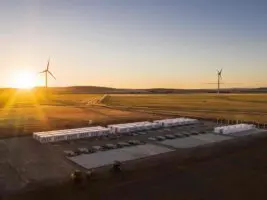The UK’s gas imports would be 13% lower if successive Conservative-led governments had not “cut the green crap” over the past decade, Carbon Brief analysis shows.
The findings come as the government’s North Sea Transition Authority announces a new licensing round for North Sea oil and gas, with the stated aim of increasing UK energy security. The analysis also follows news that the UK is at risk of blackouts if imports of gas and electricity are restricted.
Carbon Brief’s analysis shows that UK gas imports would have been cut by 65 terawatt hours (TWh) if government support for energy efficiency and renewables had continued, instead of being rolled back after then-prime minister David Cameron told ministers in 2013 to “cut the green crap”.
This saving would have been nearly twice as large as the 34TWh imported from Russia last year. It would have been sufficient to cut the UK’s net gas imports by 13% overall, significantly boosting energy security. The saving would have avoided buying 65TWh of gas at a cost of around £5bn.
Most of the savings would have been from additional onshore wind and solar capacity, which would have cut UK gas demand for electricity by 20%. Moreover, the analysis shows that gas demand for electricity generation would have been twice as high, if the UK had no renewable energy sources.
‘Cutting the green crap’
From 2013 onwards, successive Conservative-led governments cut support for home energy efficiency improvements, scrapped a requirement for new homes to be “zero carbon”, ended subsidies for onshore wind and solar, and effectively banned onshore wind in England.
This caused a precipitous decline in the rate of home energy efficiency improvements, led to millions of inefficient new homes being built and dramatically reduced the amount of onshore wind and solar capacity being built each year, as shown in Carbon Brief’s January 2022 analysis.
The new Carbon Brief analysis aggregates these climate policy rollbacks in terms of the gas demand they would have avoided, if the measures had remained in place.
In total, UK gas demand would have been 65TWh lower if it had insulated more homes (11TWh), built new homes to zero-carbon standards (2TWh) and continued to add onshore wind (31TWh) and solar (20TWh) at historical rates.
This saving from not “cutting the green crap” is shown by the red bars in the chart below, relative to UK gas demand in 2021 (grey) and relative to net UK gas imports in the same year (light blue). The chart also shows direct imports from Russia in 2021 in dark blue.
The UK’s gas imports would be 13% lower if successive Conservative-led governments had not “cut the green crap” over the past decade, Carbon Brief analysis shows.
The findings come as the government’s North Sea Transition Authority announces a new licensing round for North Sea oil and gas, with the stated aim of increasing UK energy security. The analysis also follows news that the UK is at risk of blackouts if imports of gas and electricity are restricted.
Carbon Brief’s analysis shows that UK gas imports would have been cut by 65 terawatt hours (TWh) if government support for energy efficiency and renewables had continued, instead of being rolled back after then-prime minister David Cameron told ministers in 2013 to “cut the green crap”.
This saving would have been nearly twice as large as the 34TWh imported from Russia last year. It would have been sufficient to cut the UK’s net gas imports by 13% overall, significantly boosting energy security. The saving would have avoided buying 65TWh of gas at a cost of around £5bn.
Most of the savings would have been from additional onshore wind and solar capacity, which would have cut UK gas demand for electricity by 20%. Moreover, the analysis shows that gas demand for electricity generation would have been twice as high, if the UK had no renewable energy sources.
‘Cutting the green crap’
From 2013 onwards, successive Conservative-led governments cut support for home energy efficiency improvements, scrapped a requirement for new homes to be “zero carbon”, ended subsidies for onshore wind and solar, and effectively banned onshore wind in England.
This caused a precipitous decline in the rate of home energy efficiency improvements, led to millions of inefficient new homes being built and dramatically reduced the amount of onshore wind and solar capacity being built each year, as shown in Carbon Brief’s January 2022 analysis.
The new Carbon Brief analysis aggregates these climate policy rollbacks in terms of the gas demand they would have avoided, if the measures had remained in place.
In total, UK gas demand would have been 65TWh lower if it had insulated more homes (11TWh), built new homes to zero-carbon standards (2TWh) and continued to add onshore wind (31TWh) and solar (20TWh) at historical rates.
This saving from not “cutting the green crap” is shown by the red bars in the chart below, relative to UK gas demand in 2021 (grey) and relative to net UK gas imports in the same year (light blue). The chart also shows direct imports from Russia in 2021 in dark blue.
The 65TWh of savings are nearly twice the 34TWh imported as liquified natural gas (LNG) by ship from Russia last year and would have enabled the UK to cut its gas imports by 13% overall.
At the £77 per megawatt hour average price of gas during 2022 to date, this 65TWh would have amounted to a saving worth £5bn in avoided gas costs.
Electricity supply
The majority of the savings would have come from continuing to build onshore wind and solar at historical rates, instead of seeing their growth collapse due to climate policy rollbacks.
Carbon Brief’s analysis assumes onshore wind would have grown at the same rate as in 2017, when 1.8 gigawatts (GW) was built, meaning an extra 5.4GW being built by the end of 2021. It assumes an extra 10GW of solar capacity would have been added during 2016-2021. This is based, conservatively, on adding capacity at 2016 levels, well below the peak seen in 2017.
In total, this 15GW of extra renewable capacity would have generated some 25TWh of electricity per year on average. Generating this electricity at average UK gas-fired power stations would require 51TWh of gas, because half the energy in the fuel is lost as waste heat.
This saving from not “cutting the green crap” is shown by the red bar in the chart below – a 20% cut relative to actual UK gas demand for electricity generation in 2021 (grey).
This extra onshore wind and solar capacity would have boosted UK security of supply, increasing the “derated margin” between expected peak demand and available supply to 8.1%, up from 6.3% in the “base case” recently published by the National Grid Electricity System Operator (NGESO).
This derated margin, which takes into account the expected availability of different types of power station, would have been 4.8GW, instead of 3.7GW in the NGESO base case.
In addition, the chart shows how much more gas would have been needed if the UK had not got 40% of its electricity from renewable sources in 2021.
The UK would have needed to double the 254TWh of gas used to generate electricity last year, if it had not had any supplies from wind, solar, hydro and biomass power.
This would have increased UK gas demand in 2021 by 29% at a cost of around £10bn.
This article was originally published by Carbon Brief. Republished here under a CC license. To read the original article, click here.










